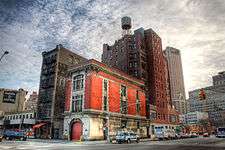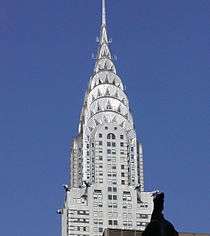Tribeca
Coordinates: 40°43′06″N 74°00′28″W / 40.718266°N 74.007819°W
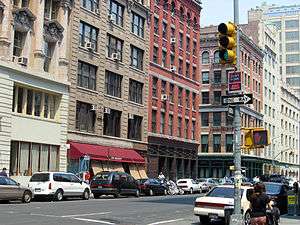
.jpg)
Tribeca /traɪˈbɛkə/, originally written as TriBeCa, is a neighborhood in Lower Manhattan, New York City. Its name is a portmanteau from "Triangle Below Canal Street". The "triangle", or more accurately, a trapezoid, is bounded by Canal Street, West Street, Broadway, and either Chambers or Vesey Streets.[1] The neighborhood is home to the Tribeca Film Festival.
Tribeca is one of a number of neighborhoods in New York City whose names are portmanteaus, including SoHo, NoHo, Nolita, NoMad, and BoCoCa, the latter of which is actually a collection of neighborhoods.
History
Etymology
The Tribeca name came to be applied to the area south of Canal Street, between Broadway and West Street, extending south to Chambers Street. In the early 1970s, a couple of years after artists in SoHo were able to legalize their live/work situation, artist and resident organizations in the area to the south, known then as Washington Market or simply the Lower West Side, sought to gain similar zoning status for their neighborhood. A group of Lispenard Street artist/residents living on triangular shaped tax block number 210, directly south of Canal Street between Church Street and Broadway, in an area now part of the landmarked Tribeca Historic District, joined the effort. Just as the members of the SoHo Artists Association called their neighborhood "SoHo" after looking at a City Planning map which marked the area as "South of Houston" (city planners had been casually using the word "SoHo" as well), these Lispenard Street residents likewise employed a City Planning map to describe their block.
Lispenard Street, east–west as is Canal, is only two blocks long and creates the first block south of Canal from West Broadway to Broadway. The Canal–Lispenard block that runs from Church Street to Broadway is wide at Church Street but is narrower at Broadway. Thus, it appears somewhat triangular on City maps, unlike a rectangle as most city blocks are depicted. The Lispenard Street residents decided to name their group the Triangle Below Canal Block Association, and, as activists had done in SoHo, shortened the group’s name to the Tribeca Block Association. A reporter covering the zoning story for The New York Times came across the block association’s submission to City Planning, and mistakenly assumed that the name Tribeca referred to the entire neighborhood, not just one block. Once the “newspaper of record” began referring to the neighborhood as Tribeca, it stuck. This was related by former resident and councilmember for the area, Kathryn Freed, who was involved in the 1970s Tribeca zoning effort.
Development
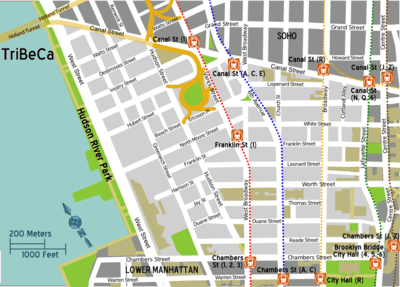
The area was among the first residential neighborhoods developed in New York beyond the boundaries of the city during colonial times, with residential development beginning in the late 18th century.
Several streets in the area are named after Anthony Lispenard Bleecker. Beach Street was created in the late 18th century and was the first street on or adjacent to the farm of Anthony Lispenard Bleecker, which was just south of what is now Canal Street; the name of the street is a corruption of the name of Paul Bache, a son-in-law of Anthony Lispenard.[2] Lispenard Street, as well as Bleecker Street in NoHo, are named for similar reasons.
By the mid-19th century the area transformed into a commercial center, with large numbers of store and loft buildings constructed along Broadway in the 1850s and 1860s. Development in the area was spurred by New York City Subway construction, namely the extension of the IRT Broadway – Seventh Avenue Line (today's 1 2 3 trains), which opened for service in 1918, and the accompanying extension of Seventh Avenue and the widening of Varick Street during subway construction in 1914, both of resulted in better access to the area for vehicles and for subway riders. The area was also served by the IRT Ninth Avenue Line, an elevated train line on Greenwich Street demolished in 1940. However, by the 1960s, Tribeca's industrial base had all but vanished, and the predominance of empty commercial space attracted many artists to the area in the 1970s. Since the 1980s, large scale conversion of the area has transformed Tribeca into an upscale residential area.
In 1996, the Tribeca Open Artist Studio Tour was founded as a non-profit, artist-run organization with the mission to empower the working artists of Tribeca while providing an educational opportunity for the public. For 15 years, the annual free walking tour through artist studios in Tribeca has allowed people to get a unique glimpse into the lives of Tribeca's best creative talent.[3] Tribeca suffered both physically and financially after the September 11, 2001 terrorist attacks, but government grants and incentives helped the area rebound fairly quickly.[4] The Tribeca Film Festival was established to help contribute to the long-term recovery of lower Manhattan after 9/11. The festival also celebrates New York City as a major filmmaking center. The mission of the film festival is "to enable the international film community and the general public to experience the power of film by redefining the film festival experience." Tribeca is a popular filming location for movies and television shows.
By the early 21st century, Tribeca became one of Manhattan's most fashionable and desirable neighborhoods, well known for its celebrity residents. In 2006, Forbes magazine ranked its 10013 zip code as New York City's most expensive (however, the adjacent, low-income neighborhood of Chinatown, also uses the 10013 zip code).[5][6] As of 2010, Tribeca was the safest neighborhood in New York City, according to NYPD and CompStat statistics.[7]
Demographics
| Historical population | |||
|---|---|---|---|
| Census | Pop. | %± | |
| 1950 | 782 | — | |
| 1960 | 382 | −51.2% | |
| 1970 | 370 | −3.1% | |
| 1980 | 5,949 | 1,507.8% | |
| 1990 | 8,386 | 41.0% | |
| 2000 | 10,395 | 24.0% | |
| 2010 | 17,056 | 64.1% | |
As of the 2000 census, there were 10,395 people residing in Tribeca. The population density was 31,467 people per square mile (12,149/km2). The racial makeup of the neighborhood was 82.34% White, 7.96% Asian, 0.03% Pacific Islander, 4.89% African American, 0.10% Native American, 1.66% from other races, and 3.02% from two or more races. 6.34% of the population were Hispanic of any race. Of the 18.2% of the population that was foreign born, 41.3% came from Europe, 30.1% from Asia, 11.1% from Latin America, 10.2% from North America and 7.3% from other regions.
Places
Tribeca is dominated by former industrial buildings that have been converted into residential buildings and lofts, similar to those of the neighboring SoHo-Cast Iron Historic District. In the 19th and early 20th centuries, the neighborhood was a center of the textile/cotton trade.
Notable buildings in the neighborhoods include the historic neo-Renaissance Textile Building built in 1901 and designed by Henry J. Hardenbergh, the Powell Building, a designated Landmark on Hudson Street, which was designed by Carrère and Hastings and built in 1892.[8] At 73 Worth Street there is a handsome row of neo-Renaissance White Buildings built at the end of the Civil War in 1865. Other notable buildings include the New York Telephone Company building at 140 West Street, between Vesey and Barclay, with its Mayan-inspired Art Deco motif, and the former New York Mercantile Exchange at 6 Harrison Street.
During the late 1960s and '70s, abandoned and inexpensive Tribeca lofts became hot-spot residences for young artists and their families because of the seclusion of lower Manhattan and the vast living space. Jim Stratton, a Tribeca resident since this period, wrote the 1977 nonfiction book entitled "Pioneering in the Urban Wilderness," detailing his experiences renovating lower Manhattan warehouses into residences.
- 32 Avenue of the Americas, an Art Deco building that is the former site of the AT&T Long Lines division.
- 388 Greenwich Street, an office building near the northwestern corner of Tribeca that is the headquarters of the corporate and investment banking arm of financial services corporation Citigroup.
- Borough of Manhattan Community College (BMCC), part of the City University of New York. The college campus is located between Chambers Street and N. Moore Street, spanning four blocks. BMCC's Fiterman Hall, severely damaged in the September 11, 2001 attacks, was demolished and has been rebuilt.[9]
- Holland Tunnel connecting New York to New Jersey has its entrances and exits in the northwest corner of Tribeca, centered around St. John's Park.
- Hook & Ladder Company No. 8, a still-in-use firehouse at North Moore Street that was the site of the filming of the Ghostbusters movies. Memorabilia from the movies are displayed inside.[10] Another film, Hitch, with Will Smith, also filmed a short but notable scene at the firehouse.[11]
- Hudson River Park, a waterside park on the Hudson River that extends from 59th Street south to Battery Park. It runs through the Manhattan neighborhoods of Lower Manhattan, Battery Park City, TriBeCa, Greenwich Village, Gansevoort Market (The Meatpacking District), Chelsea, Midtown West, Hudson Yards, and Hell's Kitchen (Clinton). It is a joint New York State and New York City collaboration and is a 550-acre (2.2 km2) park, the biggest in Manhattan after Central Park. The park arose as part of the West Side Highway replacement project in the wake of the abandoned Westway plan.
- Kitchen, Montross & Wilcox Store, a landmarked building in Tribeca built in 1861.
- Metropolitan College of New York, a private, independent educational institution, located on Canal Street.
- New York Law School, a private, independent law school that was founded in 1891, has been located in several buildings in Tribeca since 1962, principally along Worth Street between Church Street and West Broadway.
- Stuyvesant High School, one of the nine specialized high schools in New York City, is located at 345 Chambers Street in nearby Battery Park City. The Tribeca Bridge was built to assure the safety of the students who need to get across West Street to get to the building.
- Verizon Building, a landmarked building in Tribeca built between 1923–27. It is being converted into condominiums.
- Washington Market Park, bounded by Greenwich, Chambers, and West Streets, is a 1.61-acre (6,500 m2) park that is popular with children for its large playground. The park also has community gardens and hosts community events.[12]
Historic districts
There are four New York City Landmarks Preservation Commission-designated historic districts within Tribeca:
- Tribeca West – designated May 7, 1991[13]
- Tribeca East – designated December 2, 1992[14]
- Tribeca North – designated December 8, 1992[15]
- Tribeca South – designated December 8, 1992[16]
- Tribeca South Extension – designated November 19, 2002[17]
Notable people
Robert De Niro and Jane Rosenthal had high profiles in the district's revival when they co-produced the dramatic television anthology series TriBeCa in 1993 and co-founded the annual Tribeca Film Festival in 2002. De Niro also claimed ownership of all domain names incorporating the text "Tribeca" for domain names with any content related to film festivals. In particular, he had a dispute with the owner of the website tribeca.net.[32][33]
In popular culture
Although Wizards of Waverly Place includes a fictional "Tribeca Academy," exterior shots were filmed at P.S. 40 on East 20th Street, between First Avenue and Second Avenue in midtown Gramercy Park.[34] In addition, a fictional "Tribeca High School" appears in the Law & Order: Special Victims Unit episode "Granting Immunity." Local radio station WHTZ's studio is located here. In the third book of the Witches of East End series, Winds of Salem, the Oracle, an almighty god from Asgard, lives in Tribeca.
See also
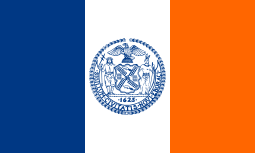 New York City portal
New York City portal
References
- ↑ "Tribeca - New York City Neighborhood - NYC". New York. Retrieved 16 July 2011.
- ↑ Henry Moscow (1990). The Street Book: An Encyclopedia of Manhattan's Street Names and Their Origins. Fordham University Press. p. 26. ISBN 9780823212750.
- ↑ "Tribeca Open Artist Studio Tour (TOAST)". Toastartwalk.com. Retrieved 2014-08-15.
- ↑ Responding to the 9/11 Terrorist Attacks: Lessons from Relief and Recovery in NYC Archived February 19, 2009, at the Wayback Machine.
- ↑ Most Expensive ZIP Codes 2006, Forbes, accessed November 6, 2006
- ↑ "10013 Zip Code (New York, New York)". City-data.com. Retrieved 2014-08-15.
- ↑ Manley, Charles. "The Safest and Most Dangerous Areas of New York City" on the Yahoo! Voices website
- ↑ Gray, Christopher (June 25, 2000). "Streetscapes/105 Hudson Street; A TriBeCa Taste of the Young Carrere & Hastings". The New York Times. Retrieved July 18, 2010.
- ↑ "Fiterman Hall is now open!". Borough of Manhattan Community College. Retrieved February 16, 2013.
- ↑ Plagianos, Irene. "There's a New Ghostbusters Logo at TriBeCa's famed Ladder 8 Firehouse", DNAinfo.com, July 7, 2015. Accessed July 19, 2016. "TriBeCa's famed Ladder 8 firehouse — used as the headquarters for the ghoul hunting troupe in the classic 1984 comedy — has an updated Ghostbusters emblem painted on the sidewalk outside its 12 N. Moore Street firehouse."
- ↑ Puglise, Nicole. "Original Ghostbusters firehouse gets a new feature: a women's bathroom; The 1903 Manhattan firehouse which featured in the original 1984 film is undergoing major renovations, in part to accommodate female employees", The Guardian, July 13, 2016. Accessed July 19, 2016. "The exterior of the building was used for the 1984 film and its 1989 sequel, as well as an episode of Seinfeld and the Will Smith movie Hitch."
- ↑ Washington Market Park, New York City Department of Parks and Recreation. Accessed July 19, 2016.
- ↑ "NYCLPC Tribeca West Historic District Designation Report"
- ↑ "NYCLPC Tribeca East Historic District Designation Report"
- ↑ "NYCLPC Tribeca North Historic District Designation Report"
- ↑ "NYCLPC Tribeca South Historic District Designation Report"
- ↑ "NYCLPC Tribeca South Historic District Extension Designation Report"
- ↑ Staff. "Albee's Loft; Edward Albee's 6,000-square-foot loft in a former cheese warehouse in New York's Tribeca neighborhood houses his expansive collection of fine art, utilitarian works and sculptures. (See related article.)", Wall Street Journal, March 11, 2010. Accessed July 1, 2016.
- ↑ "Shapiro, Julie. ''Artist's 9/11 Sculpture Rises in TriBeCa ''". Dnainfo.com. 2011-05-05. Retrieved 2014-08-15.
- 1 2 David, Amrk. "Paul Bettany and Jennifer Connelly On the Move Again", Variety (magazine), January 14, 2012. Accessed July 19, 2016. "It was only about 3.5 years ago that English-born movie actor Paul Bettany (A Beautiful Mind, The Da Vinci Code, A Knight's Tale) and Brooklyn-bred Academy Award winner Jennifer Connelly (A Beautiful Mind, Requiem For A Dream, Blood Diamond) paid $6,920,000 for a full floor loft-type penthouse apartment on the edge of New York City’s star-stocked TriBeCa neighborhood."
- ↑ Richards, David. "Bogosian in the Burbs", The Washington Post, May 5, 1996. Accessed July 19, 2016. "Yet all the signs suggest he's no longer the fringe personality he once was. He, his wife and two young sons live in a spacious loft in TriBeCa, and he recently rented a suite of offices for Ararat Productions, his own production company (named after the mountain where Noah's Ark landed)."
- ↑ Osterhout, Jacob E. "Ed Burns manages to stay grounded in his native Tribeca despite success over last decade", New York Daily News, April 21, 2011. Accessed July 19, 2016. "Meandering through the streets of his Tribeca neighborhood in jeans and shell-toe Adidas, Burns puts on no airs."
- ↑ Clarke, Gerald. "Mariah Carey's New York TriplexGlitter and glamour sound a high note in the singer's Manhattan home, decorated by Mario Buatta", Architectural Digest, October 31, 2001. Accessed July 19, 2016. "Now, after a decade in which Carey has been the world’s most popular female vocalist, her albums and singles selling more than one hundred and fifty million copies; now, after a new contract with Virgin Records that will bring her nearly one hundred and twenty million dollars for her next five CDs; now, after the September opening of her first movie, the semiautobiographical Glitter; and now, after completion of a spacious triplex in Tribeca that harks back to an era Carey dreams about—the golden age of Hollywood."
- ↑ Does Daniel Craig's Fabulous New Penthouse Make Him Gay? Gawker.com. Retrieved May 27, 2010
- ↑ A Lena Dunham Locale NYTimes.com. Retrieved October 10, 2014
- ↑ acre-malibu-property/517/celebrities U2's Edge Settles into $4.3 Million Tribeca Penthouse bergproperties.com. Retrieved June 17, 2007
- ↑ Freydkin, Donna (April 27, 2007). "Stars toast Tribeca artists at Chanel fete". USA Today. Retrieved June 18, 2007.
- ↑ NY Times, Liz Harris, Where Rent Is Stabilized, Reopening After Storm Is No Certainty
- ↑ Weiss, Murray; Italiano, Laura; Mangan, Dan (October 3, 2009). "Sex-diary find set off 'extort'". New York Post. Retrieved January 17, 2010.
- ↑ Schoeneman, Deborah (May 21, 2005). "The Return of Canastel's". New York Magazine. Retrieved June 19, 2007.
- ↑ Clemence, Sara (May 13, 2005). "House Of Stewart". Forbes Magazine. Retrieved June 17, 2007.
- ↑ Davis, Erik (January 2, 2007). "Robert De Niro: Raging Bully?". Archived from the original on January 4, 2007.
- ↑ "I am Tribeca, De Niro claims". New York Post. December 31, 2006. Archived from the original on January 10, 2007.
- ↑ Wizards of Waverly Place Trivia Facts. ShareTV. Retrieved on 2013-07-19.
External links
| Wikimedia Commons has media related to Tribeca, Manhattan. |
| Wikivoyage has a travel guide for TriBeCa. |
Community groups and organizations
- Tribeca Film Festival
- Tribeca Trust - a community organization working on historic preservation and public spaces
Images
- Tribeca in the 1970s – Early photos of the neighborhood
Neighborhood guides
- tribeca.org – Neighborhood history, dining, shopping, arts and entertainments (maintained by the Tribeca Organization)
- Tribeca Family Festival
- Tribeca Neighborhood Profile – About.com
- Tribeca Open Artist Studio Tour (TOAST)
- Tribeca Walking Tour
News and blogs
- Battery Park Blog - Covering Battery Park City, the Financial District, and Tribeca
- The Battery Park City Broadsheet - Local news throughout Battery Park City, Tribeca, South Street Seaport and the Financial District
- Downtown Express – Weekly, local newspaper of Lower Manhattan
- The Tribeca Citizen
- The Tribeca Trib – The Tribeca Trib; neighborhood newspaper in circulation since 1994

